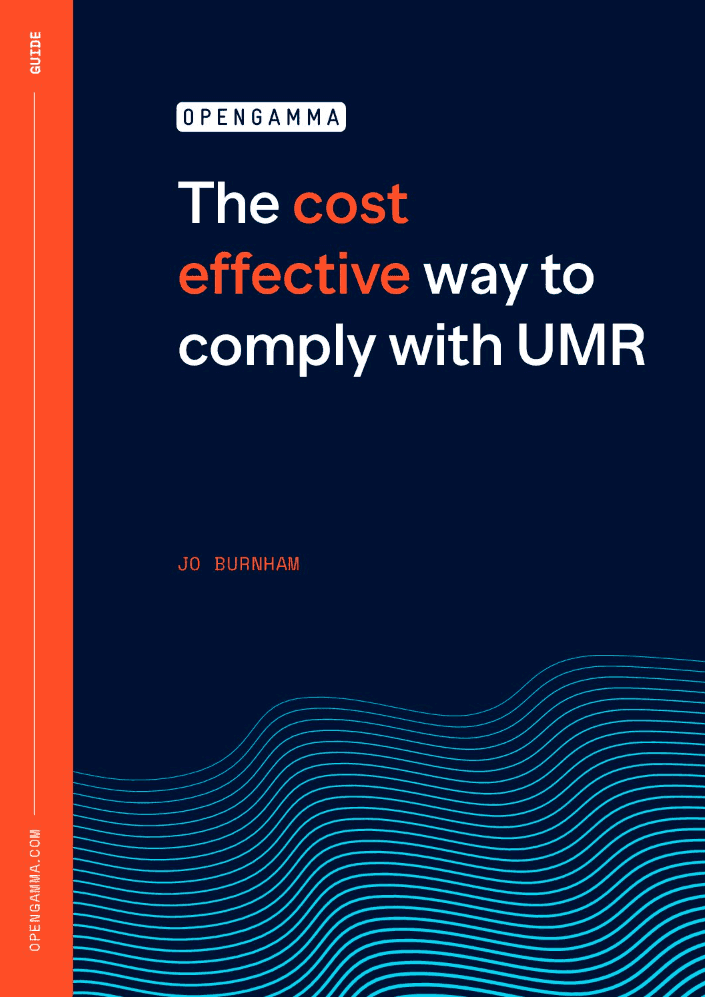Comply With Uncleared Margin Rules In A Cost Effective Manner
Uncleared Margin Rules Explained
Uncleared Margin Rules (UMR) were introduced by the BCBS and IOSCO in 2016 as one of the two major reforms to mitigate systemic risk in the industry following the 2008 financial crisis. UMR applies to all financial firms and systemically important non-financial firms. The rules have been capturing firms in four phases to-date.
In this ebook, we look at the most cost effective way to comply with Uncleared Margin Rules, whether that is in terms of the amount of margin paid or the requirements of any solutions implemented to ensure compliance. By making the correct choices, firms can avoid paying millions in bilateral margin, and also limit the cost of complying with this new UMR regulation to the minimum.
Margin Calculation
In our first chapter we look into the difference between two UMR-compliant methodologies, that being SIMM or Grid. We look into which methodology should be the main margin methodology. The choice of margin methodology can impact both the operational complexity of implementing UMR as well as the level of margin requirements. Firms should actively think about which methodology to use for bilateral margining.
Margin Reconciliation
In this chapter, we emphasise why margin reconciliation is so important. Additionally, we also emphasise the importance of the correct margin being charged under UMR, and this can be done through a simple process that checks margin requirement changes and ensures that they reflect the daily change in risk of their portfolio. Lastly, we look at how a more traditional approach to margin call validation can provide a more efficient and cost-effective solution for Newly in Scope Counterparties (NISCs).
Margin Optimisation
With Margin Optimisation it can be a tool that can help firms minimise the impact of UMR. However there are also considerations to take note of, this chapter delves into these considerations.
Additionally, to optimise initial margin requirements firms need to keep below the $50 million threshold with counterparties. Given that the risk on a portfolio will change over time, this is something that needs to be carried out both pre- and post-trade. In the Margin Optimisation chapter we will provide examples and we will go into detail about pre-trade and post-trade, and discuss the differences between the two.
Solution Considerations
In our last chapter we provide potential solutions for each of the previous sections that were mentioned within the Ebook.
Calculation
Cost effective compliance with uncleared margin rules is important, but what happens when a definitive decision can’t be made between Grid and SIMM? It may be better to have a solution that is able to support both methodologies.
Reconciliation
Which is more effective, a simple reconciliation based on change of margin or a complex middleware solution dependent on trade by trade matching of sensitivity calculations? We provide the answer.
Optimisation
The most cost effective way to comply with Uncleared Margin Rules is not to pay margin. In order to do this it is necessary to stay below the margin threshold. This means having a solution that lets firms determine the best place to trade, be it the choice of broker or whether to move from bilateral to cleared. It is important that all solutions should offer three specific functionalities, our Ebook details what those three functionalities are.
Download Our Ebook To Learn The Cost Effective Way To Comply With Uncleared Margin Rules
This blog is just a small glimpse into our Ebook. Our Ebook provides a comprehensive guide on the cost effective way to comply with uncleared margin rules, and how firms can avoid paying millions in bilateral margin.



